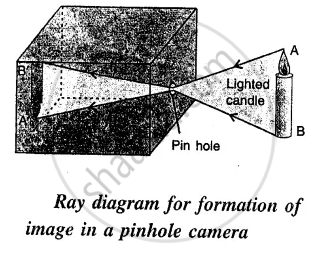Advertisements
Advertisements
प्रश्न
Explain the formation of the image of a luminous object in a pinhole camera with the aid of a neat diagram.
उत्तर
When a luminous object AB, such as a lighted candle, is placed in front of the pinhole, an inverted picture A’ B’ of the candle is
obtained on the tracing paper. This picture A’ B’ is called the image. The image obtained is upside down (i. e. inverted). The reason is that the light travels in a straight-line path. Hence light from the upper point A of the candle passes through the pinhole and strikes
the tracing paper at A’. Similarly, light from the lower point B of the candle passes through the pinhole and strikes the tracing paper
(or screen) at B’. Light from all the other points between A and B, on passing through the pinhole strikes the tracing paper in between
A’ and B’. As a result, an inverted image of the candle is seen on the tracing paper Fig shows the simple ray diagram for die formation of the image.

APPEARS IN
संबंधित प्रश्न
Write true or false of the following statement.
Image formed in a pinhole camera is real.
Is the image obtained in a pinhole camera erect or inverted? Give reason for your answer.
How is the image affected in a pinhole camera when another fine hole is made near the first pinhole?
State the effect on the image in a pinhole camera if the luminous object is moved towards the pinhole.
State the effect on the image in a pinhole camera if The length of the pinhole camera is increased (length the screen is moved away from the pinhole).
Fill in the blank
Pinhole camera is based on the ................... propagation of light.
Write true or false
Image formed in a pinhole camera is erect.
The image obtained in the pinhole camera is ______.
Compare the images formed by plane mirror with that by pinhole camera
______ camera is a simple device that helps us to understand the rectilinear propagation of light.
